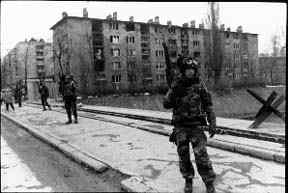




 |
 |
 |
 |
 |
|
| Contents Forward Backwards |
|
No building in Sarajevo represents the magnitude of destruction more than the twin Unis Towers in Sarajevo. Home to the largest commercial enterprise in Bosnia, it was reduced to a skeleton of twisted steel and broken glass. Adjacent to but much taller than the Holiday Inn in New Sarajevo, the Unis Towers were a clear shot for Serb snipers and artillery men in the hills across the Miljacka River and in neighboring Grbavica, a Serb- controlled ghetto. Perhaps presaging the possibility of warfare, all of the glass in the buildings was double-paned and bulletproof, but not bulletproof enough to stop the firepower unleashed by those intent on dividing and destroying the city. A much greater human toll was taken in Grbavica, a modern neighborhood across the river from the Unis Towers. (The soldier above stands on the bridge into Grbavica.) Bordering the larger land areas conquered by the Serb nationalists, Grbavica was easily taken, then defended and supplied by its Serb occupiers. Muslim residents (who never thought much about their ethnic identity prior to the war) were either driven from their homes, summarily executed, or forced into work brigades. Some of the more horrific accounts of the division of Sarajevo include details of private concentration camps in Grbavica basements where unspeakable atrocities were committed. While people were starving and dying of the cold in New Sarajevo, Serb residents of Grbavica had a steady supply of consumer goods and fuel coming from Srpska. |
  |